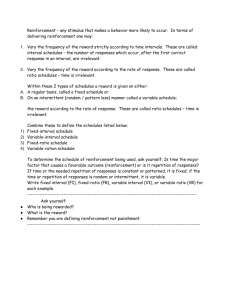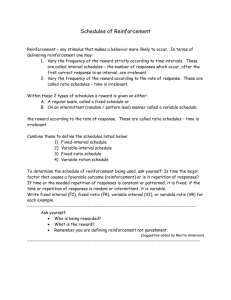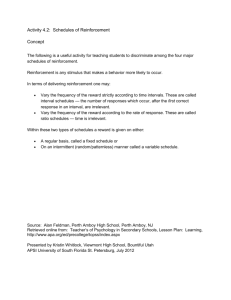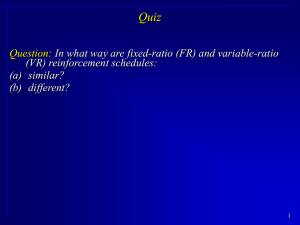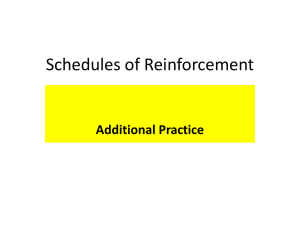Basic Schedules of Reinforcement
advertisement
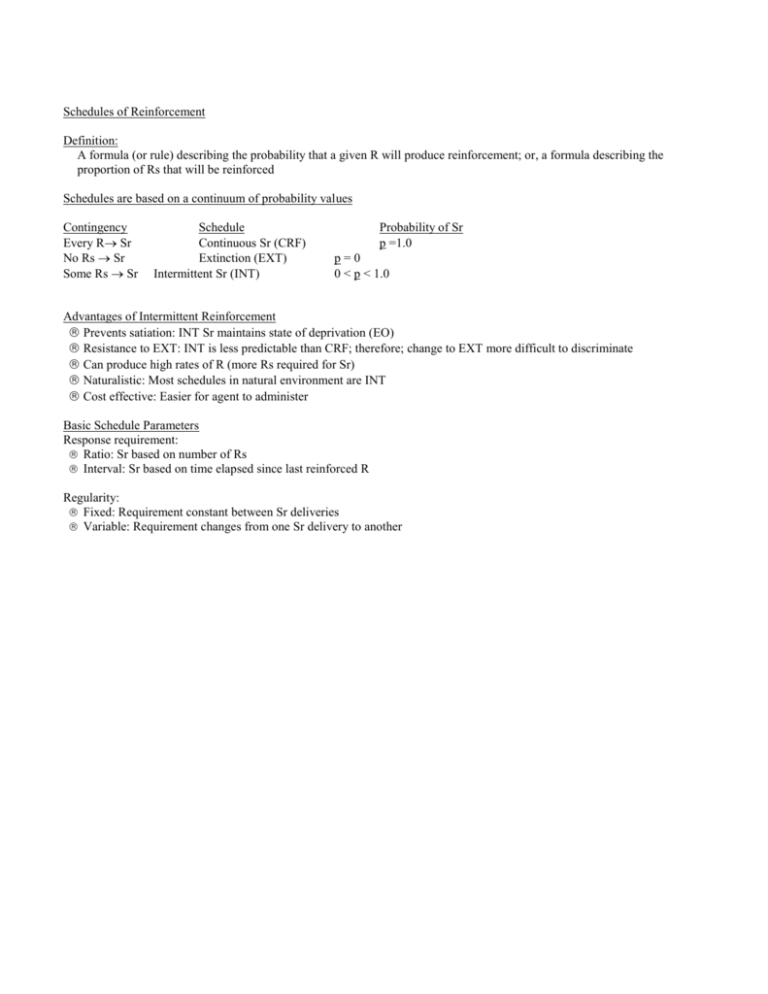
Schedules of Reinforcement Definition: A formula (or rule) describing the probability that a given R will produce reinforcement; or, a formula describing the proportion of Rs that will be reinforced Schedules are based on a continuum of probability values Contingency Every R Sr No Rs Sr Some Rs Sr Schedule Continuous Sr (CRF) Extinction (EXT) Intermittent Sr (INT) Probability of Sr p =1.0 p=0 0 < p < 1.0 Advantages of Intermittent Reinforcement Prevents satiation: INT Sr maintains state of deprivation (EO) Resistance to EXT: INT is less predictable than CRF; therefore; change to EXT more difficult to discriminate Can produce high rates of R (more Rs required for Sr) Naturalistic: Most schedules in natural environment are INT Cost effective: Easier for agent to administer Basic Schedule Parameters Response requirement: Ratio: Sr based on number of Rs Interval: Sr based on time elapsed since last reinforced R Regularity: Fixed: Requirement constant between Sr deliveries Variable: Requirement changes from one Sr delivery to another Basic Schedules of Reinforcement Ratio (# of Rs) Interval (Time since last reinforced R) Fixed (Requirement for Sr constant) FIXED RATIO (FR) Sr delivered following fixed # of Rs FIXED INTERVAL (FI) Sr delivered following 1st R after fixed amt time since last reinforced R Variable (Requirement for Sr changes) VARIABLE RATIO (VR) VARIABLE INTERVAL (VR) Sr delivered following Sr delivered following 1st R # Rs that varies around after variable amt time since an average value last reinforced R Schedule Effects on Behavior Ratio (High R rate) Fixed (Irregular R rate) FIXED RATIO (FR) High, irregular rate (“Break and run”) Variable (Stable R rate) VARIABLE RATIO (FR) High stable rate Interval (Moderate R rate) FIXED INTERVAL (FI) Moderate irregular rate (“FI scallop”) VARIABLE INTERVAL (VI) Moderate stable rate Response Patterns Generated by Basic Schedules 40 CUMULATIVE # OF RESPONSES VR: High stable rate FIXED RATIO 30 VARIABLE RATIO FR: High irregular rate FIXED INTERVAL VARIABLE INTERVAL 20 VI: Moderate stable rate FI: Moderate irregular rate 10 0 0 10 20 30 40 SESSON TIME DeLuca & Holborn (1992) General Focus: Application of behavioral principles to the treatment of childhood obesity Specific Aims: To increase rates of exercise To determine whether VR schedules are more effective than FR and FI schedules To use a changing criterion design to shape gradual increases in behavior Procedures Experimental Designs: Changing Criterion (BL + 3 VR phases) Reversal: A-B1-B2-B3-A-B3 Conditions: Baseline: No special instructions or contingencies Reinforcement (VR): VR point schedule (+15% BL or previous phase) 50 VR signaled via bell and light Points exchanged for backup Sr+ (based on survey) Social Validity: Satisfaction, physical activity, appearance (Ss, patents, teachers) Results Participant Scott (N) Shawn (N) Steve (N) Peter (O) Paul (O) Perry (O) BL Stable ∆∆Stable Stable Stable VR#1 ∆++ ∆++ ∆++ ∆++ ∆++ ∆++ VR#2 ∆+ ∆+ ∆+ ∆+ ∆+ ∆+ VR#3 ∆+ ∆++ ∆+ ∆++ ∆+ ∆+ BL ∆∆∆∆∆∆- VR#3 ∆++ ∆++ ∆+ ∆++ ∆++ ∆+ Implications and Extensions Major contribution: Interesting application of Sr schedules and changing criterion design as shaping procedure for increasing exercise behavior Limitations: Was performance under VR better than under FR or FI? Were criterion increases necessary? Other indices of improvement? Extensions: IV: Schedule questions unanswered DV: Additional measures of benefit DV: Other forms of exercise (convenience) DV: Other behaviors related to obesity Population or setting

